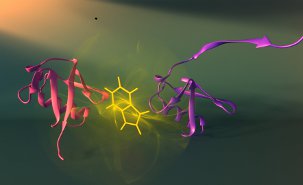There are other teams working on ways to breach the blood-brain barrier (my March 26, 2015 post highlights work from a team at the University of Montréal) but this team from Cornell is working with a drug that has already been approved by the US Food and Drug Administration (FDA) according to an April 8, 2016 news item on ScienceDaily,
Cornell researchers have discovered a way to penetrate the blood brain barrier (BBB) that may soon permit delivery of drugs directly into the brain to treat disorders such as Alzheimer’s disease and chemotherapy-resistant cancers.
The BBB is a layer of endothelial cells that selectively allow entry of molecules needed for brain function, such as amino acids, oxygen, glucose and water, while keeping others out.
Cornell researchers report that an FDA-approved drug called Lexiscan activates receptors — called adenosine receptors — that are expressed on these BBB cells.
An April 4, 2016 Cornell University news release by Krishna Ramanujan, which originated the news item, expands on the theme,
“We can open the BBB for a brief window of time, long enough to deliver therapies to the brain, but not too long so as to harm the brain. We hope in the future, this will be used to treat many types of neurological disorders,” said Margaret Bynoe, associate professor in the Department of Microbiology and Immunology in Cornell’s College of Veterinary Medicine. …
The researchers were able to deliver chemotherapy drugs into the brains of mice, as well as large molecules, like an antibody that binds to Alzheimer’s disease plaques, according to the paper.
To test whether this drug delivery system has application to the human BBB, the lab engineered a BBB model using human primary brain endothelial cells. They observed that Lexiscan opened the engineered BBB in a manner similar to its actions in mice.
Bynoe and Kim discovered that a protein called P-glycoprotein is highly expressed on brain endothelial cells and blocks the entry of most drugs delivered to the brain. Lexiscan acts on one of the adenosine receptors expressed on BBB endothelial cells specifically activating them. They showed that Lexiscan down-regulates P-glycoprotein expression and function on the BBB endothelial cells. It acts like a switch that can be turned on and off in a time dependent manner, which provides a measure of safety for the patient.
“We demonstrated that down-modulation of P-glycoprotein function coincides exquisitely with chemotherapeutic drug accumulation” in the brains of mice and across an engineered BBB using human endothelial cells, Bynoe said. “The amount of chemotherapeutic drugs that accumulated in the brain was significant.”
In addition to P-glycoprotein’s role in inhibiting foreign substances from penetrating the BBB, the protein is also expressed by many different types of cancers and makes these cancers resistant to chemotherapy.
“This finding has significant implications beyond modulation of the BBB,” Bynoe said. “It suggests that in the future, we may be able to modulate adenosine receptors to regulate P-glycoprotein in the treatment of cancer cells resistant to chemotherapy.”
Because Lexiscan is an FDA-approved drug, ”the potential for a breakthrough in drug delivery systems for diseases such as Alzheimer’s disease, Parkinson’s disease, autism, brain tumors and chemotherapy-resistant cancers is not far off,” Bynoe said.
Another advantage is that these molecules (adenosine receptors and P-glycoprotein are naturally expressed in mammals. “We don’t have to knock out a gene or insert one for a therapy to work,” Bynoe said.
The study was funded by the National Institutes of Health and the Kwanjung Educational Foundation.
Here’s a link to and a citation for the paper,
A2A adenosine receptor modulates drug efflux transporter P-glycoprotein at the blood-brain barrier by Do-Geun Kim and Margaret S. Bynoe. J Clin Invest. doi:10.1172/JCI76207 First published April 4, 2016
Copyright © 2016, The American Society for Clinical Investigation.
This paper appears to be open access.

